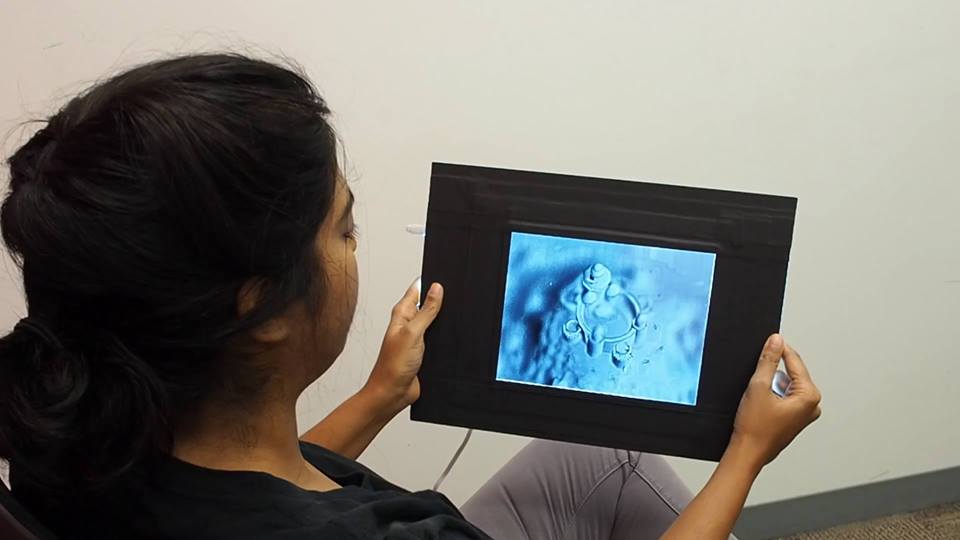 Holograms were one of my favorite things as a child. I had stickers and bookmarks featuring silver moons and stars that shimmered and shifted in and out of view, or horses that galloped across a field as you tilted the images. Magical – and magically distracting in class, as I subtly shifted my holographic notebooks and folders back and forth to watch the light show instead of paying attention to the teacher.
Holograms were one of my favorite things as a child. I had stickers and bookmarks featuring silver moons and stars that shimmered and shifted in and out of view, or horses that galloped across a field as you tilted the images. Magical – and magically distracting in class, as I subtly shifted my holographic notebooks and folders back and forth to watch the light show instead of paying attention to the teacher.
Back then, I didn’t understand the technology required to create holograms, which made them seem even more magical, and I just took it for granted that I’d never be able to make my own. Today’s children will have no such illusions about optical illusions. Boston tech company Lumii is working on a technology that they’re calling “the first commercial light field display engine,” and it’s essentially going to let people print their own holograms, using a combination of 2D and 3D methods.
The startup began at the Massachusetts Institute of Technology where Matthew Hirsch, Thomas A. Baran and Daniel Leithinger were working on PhD programs. A combination of their respective fields of study led to the formation of Lumii and its light field technology, which is still in development, currently in a limited alpha testing phase. It should be coming to the masses soon, however, and recently attendees at Siggraph 2016 got a sneak peek at the technology via – what else? – holographic selfies.
At the Lumii booth, visitors had their faces 3D scanned to produce detailed, full-color images of themselves. Instead of receiving a 3D file or a 3D print of their likenesses, however, they watched as their photos were printed out on an ordinary 2D inkjet printer. The prints that came out were anything but ordinary, though – they were 3D images with shimmering, holographic backgrounds.
“The way we do it is, instead of using specialized optics like lenses, we use algorithms to take a 3D model…and we turn that into special patterns, and when you print the patterns and layer them on top of one another, you get a 3D effect,” said Baran. “…It’s a full parallax image, so that means you can look at it horizontally, and turn your head and look at it vertically and still see the 3D effect.”
The technology drew plenty of interest from the crowds at Siggraph, as a growing gallery of hologram-like portraits amassed at the Lumii booth. Light field technology isn’t just a novelty, though. Sure, the ability to take holographic selfies is going to grab the attention of the general public, but the technology has real potential to be useful in several industries. Advertising is a major target area, but interest has already been expressed by companies in the fields of medicine, architecture and construction.
Light field technology could be a valuable tool for artists and makers, too – look at the amazing creativity that has been shown in leveraging other digital media forms to create art. Again, Lumii’s light field technology is still in the alpha phase, but if you want to be the first to experiment with this new method of design, you can sign up to be an alpha tester here. Discuss further in the 3D Printed Holography forum over at 3DPB.com.
Subscribe to Our Email Newsletter
Stay up-to-date on all the latest news from the 3D printing industry and receive information and offers from third party vendors.
You May Also Like
Gorilla Sports GE’s First 3D Printed Titanium Cast
How do you help a gorilla with a broken arm? Sounds like the start of a bad joke a zookeeper might tell, but it’s an actual dilemma recently faced by...
Nylon 3D Printed Parts Made More Functional with Coatings & Colors
Parts 3D printed from polyamide (PA, Nylon) 12 using powder bed fusion (PBF) are a mainstay in the additive manufacturing (AM) industry. While post-finishing processes have improved the porosity of...
$25M to Back Sintavia’s Largest Expansion of Metal 3D Printing Capacity Since 2019
Sintavia, the digital manufacturing company specializing in mission-critical parts for strategic sectors, announced a $25 million investment to increase its production capacity, the largest expansion to its operations since 2019....
Velo3D Initiates Public Offering in a Bid to Strengthen Financial Foundations and Drive Future Growth
Velo3D (NYSE: VLD) has been among a number of publicly traded 3D printing firms that have attempted to weather the current macroeconomic climate. After posting a challenging financial report for 2023,...
































